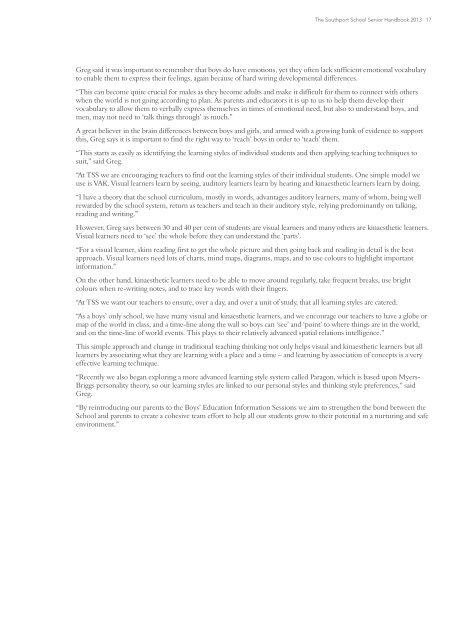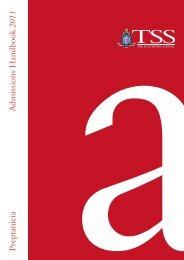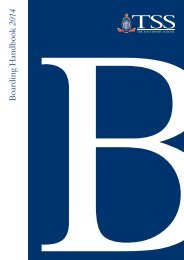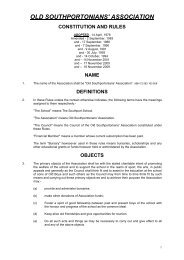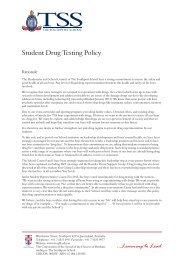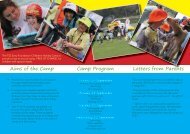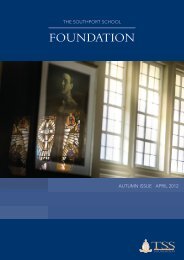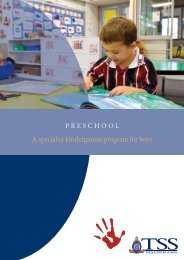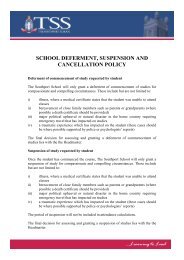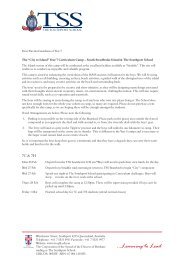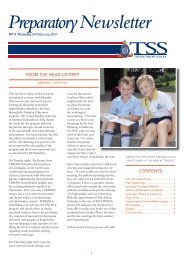2013 Senior Admissions Handbook - The Southport School
2013 Senior Admissions Handbook - The Southport School
2013 Senior Admissions Handbook - The Southport School
You also want an ePaper? Increase the reach of your titles
YUMPU automatically turns print PDFs into web optimized ePapers that Google loves.
<strong>The</strong> <strong>Southport</strong> <strong>School</strong> <strong>Senior</strong> <strong>Handbook</strong> <strong>2013</strong> 17<br />
Greg said it was important to remember that boys do have emotions, yet they often lack sufficient emotional vocabulary<br />
to enable them to express their feelings, again because of hard wiring developmental differences.<br />
“This can become quite crucial for males as they become adults and make it difficult for them to connect with others<br />
when the world is not going according to plan. As parents and educators it is up to us to help them develop their<br />
vocabulary to allow them to verbally express themselves in times of emotional need, but also to understand boys, and<br />
men, may not need to ‘talk things through’ as much.”<br />
A great believer in the brain differences between boys and girls, and armed with a growing bank of evidence to support<br />
this, Greg says it is important to find the right way to ‘reach’ boys in order to ‘teach’ them.<br />
“This starts as easily as identifying the learning styles of individual students and then applying teaching techniques to<br />
suit,” said Greg.<br />
“At TSS we are encouraging teachers to find out the learning styles of their individual students. One simple model we<br />
use is VAK. Visual learners learn by seeing, auditory learners learn by hearing and kinaesthetic learners learn by doing.<br />
“I have a theory that the school curriculum, mostly in words, advantages auditory learners, many of whom, being well<br />
rewarded by the school system, return as teachers and teach in their auditory style, relying predominantly on talking,<br />
reading and writing.”<br />
However, Greg says between 30 and 40 per cent of students are visual learners and many others are kinaesthetic learners.<br />
Visual learners need to ‘see’ the whole before they can understand the ‘parts’.<br />
“For a visual learner, skim reading first to get the whole picture and then going back and reading in detail is the best<br />
approach. Visual learners need lots of charts, mind maps, diagrams, maps, and to use colours to highlight important<br />
information.”<br />
On the other hand, kinaesthetic learners need to be able to move around regularly, take frequent breaks, use bright<br />
colours when re-writing notes, and to trace key words with their fingers.<br />
“At TSS we want our teachers to ensure, over a day, and over a unit of study, that all learning styles are catered.<br />
“As a boys’ only school, we have many visual and kinaesthetic learners, and we encourage our teachers to have a globe or<br />
map of the world in class, and a time-line along the wall so boys can ‘see’ and ‘point’ to where things are in the world,<br />
and on the time-line of world events. This plays to their relatively advanced spatial relations intelligence.”<br />
This simple approach and change in traditional teaching thinking not only helps visual and kinaesthetic learners but all<br />
learners by associating what they are learning with a place and a time – and learning by association of concepts is a very<br />
effective learning technique.<br />
“Recently we also began exploring a more advanced learning style system called Paragon, which is based upon Myers-<br />
Briggs personality theory, so our learning styles are linked to our personal styles and thinking style preferences,” said<br />
Greg.<br />
“By reintroducing our parents to the Boys’ Education Information Sessions we aim to strengthen the bond between the<br />
<strong>School</strong> and parents to create a cohesive team effort to help all our students grow to their potential in a nurturing and safe<br />
environment.”


